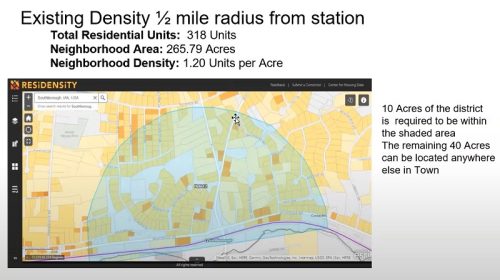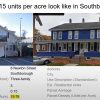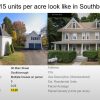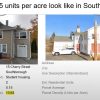Above: A presentation at Planning Board’s meeting this week highlighted one area where at least 10 acres need to be zoned to allow denser housing. The other 40 acres can be sited elsewhere. (image cropped from video)
The Planning Board is leading the Town’s effort to comply with state requirements to allow denser housing in communities with MBTA public transit. Under the guidelines, 50 acres in town would be zoned to allow up to 15 housing units per acre by-right.
The board is still in early stages with plans to educate the public and solicit feedback on where the zoning should be Overlayed.
Their broad goal is to bring a zoning bylaw Article to Annual Town Meeting in March 2024. If it fails, that would allow them time to bring a revised Article to a Special Town Meeting in the fall. (The state’s deadline for compliance is the end of that calendar year.)
Depending on how the Article is written, it may only require a simple majority to pass under recent changes to state laws.
Zoning Intent
The MBTA Communities zoning regulations signed into law by Governor Baker are meant to help increase the amount of housing on the market and simultaneously encourage use of pubic transportation.
A presentation at Monday’s Planning Board meeting explained that if zoning is:
done correctly, it is one of the most powerful tools we have to meet our goals for housing, transportation, climate, and diversity.
Although it is meant to increase affordable options for housing — it isn’t an “Affordable Housing” measure. Instead it seeks to fill the gap in the market of “Missing Middle Housing”, described in the presentation as:
modest, gentle density housing options intended for those who are not eligible for income-restricted affordable housing but who cannot afford current market prices
A graphic demonstrates a wide range of options: duplexes (side-by-side/stacked, stacked fourplexes, courtyard buildings, cottage courts, townhouses, medium sized multiplexes, stacked triplexes, and live-work buildings.
Zoning Requirements
The presentation at Planning’s Meeting included examples of multi-family homes in Southborough to give context for what the 15.0 density (15 units per acre) could look like in neighborhoods. (Most examples were lower density):
Answering questions, Planning Board Chair Meme said that the zoning can still restrict building height and setbacks.
The 50 acres of zoning can be split into multiple areas of town, but with restrictions. 10 Acres must be from the 266 acres within the 1/2 mile of the train station.
At the meeting, SHOPC member Tom Bhisitkul noted that zoning can’t be in a single development site or project that the Town intends to pursue. He did believe that they would be allowed to include 21 Highland Street. (SHOPC and Capital Planning had researched opportunities to use it as an Affordable Housing site.) Luttrell said she would double check that with DHCD, since that wasn’t her understanding.
Zoning can require up to 10% of units be affordable for those with household income up to 80% of the Area Median Income. The income level can’t be lowered, but units can be increased to 20% of developments if the Town proves to the state that projects would still be economically feasible. At this point, Luttrell advocated that it is simpler to stick with the 10%.
Luttrell wants to follow the example that Lexington set in successful public outreach. She plans to hold public forums ask for resident input on where zoning makes sense, seek feedback proposed zoning, and hold hearings.
More Background on Town Official’s Response to State Requirements
Last year, a letter from Town officials asked the state to ease the initially posted requirements. They pointed out that the 50 acres required within 1/2 mile radius of the station was more challenging than in other towns since the train it lies on the border to Hopkinton. It is also an area with many wetlands and where more of the less expensive homes already exist.
The requirement wasn’t cut in half as requested. But only 10 acres will need to be near the station and the other 40 acres can be elsewhere in town.
The original guidelines posted by the state prohibited adding an Affordability requirement to the zoning. That was another objection that Southborough (and many others) voiced during the public feedback period. The guidelines were revised to allow Towns to add some limited requirements.
The new regulations were meant to operate as a carrot & stick — only Towns that cooperated would be eligible for certain state grants. Town officials determined that the grants weren’t ones the Town generally uses and that the costs for complying could be great if it leads to a population spike. But, the new Attorney General (Andrea Campbell) has threatened to bring civil litigation against towns that don’t comply.
In April, the Select Board, Planning Board, Advisory Committee, SHOPC, and the Affordable Housing Trust Committee held a joint discussion. Advisory Chair Andrew Pfaff posited that the regulations might qualify as an unfunded mandate. He suggested looking into pushing back. Others referred to class action law suits some towns were considering.
Some of the members spoke about a desire to increase housing, but they would like to see more significant Affordability requirements.
Bhisitkul argued on behalf of pursuing the bylaw. He noted that even without an Affordability requirement, the denser housing would be more in the ballpark of $650K instead of those that are $950K to over $1M. Lisa Braccio (then on the Select Board and now on Planning) higlighted the risk that older homes priced around $300K near the train station will be replaced by multi-family housing that sometimes sells at $700k.
Officials also debated whether it made sense to use the land on the market at Dell/EMC for most of the zoning. Since it is off of Route 9, it wouldn’t have residential abutters to object. But it would also be guarantied to be quickly developed with hundreds of units. That spike would burden the schools and town resources.
Growth would be more gradual if zoned over existing residential areas, but it might face objections from residents who don’t want changes to their neighborhoods.
The group agreed that the Planning Board would continue to do the job it committed to when they filed the Town’s plan with DHCD — pursuing a zoning bylaw to be passed by Town Meeting voters.
At this week’s meeting, Select Board member Al Hamilton asked Planning to take a “holistic approach” and consider any rules and regulations, including under other boards, that might interfere with the ability for people to make use of the new zoning.
You can learn more about the initiative by watching the Planning Board’s June 12th meeting, starting here.





